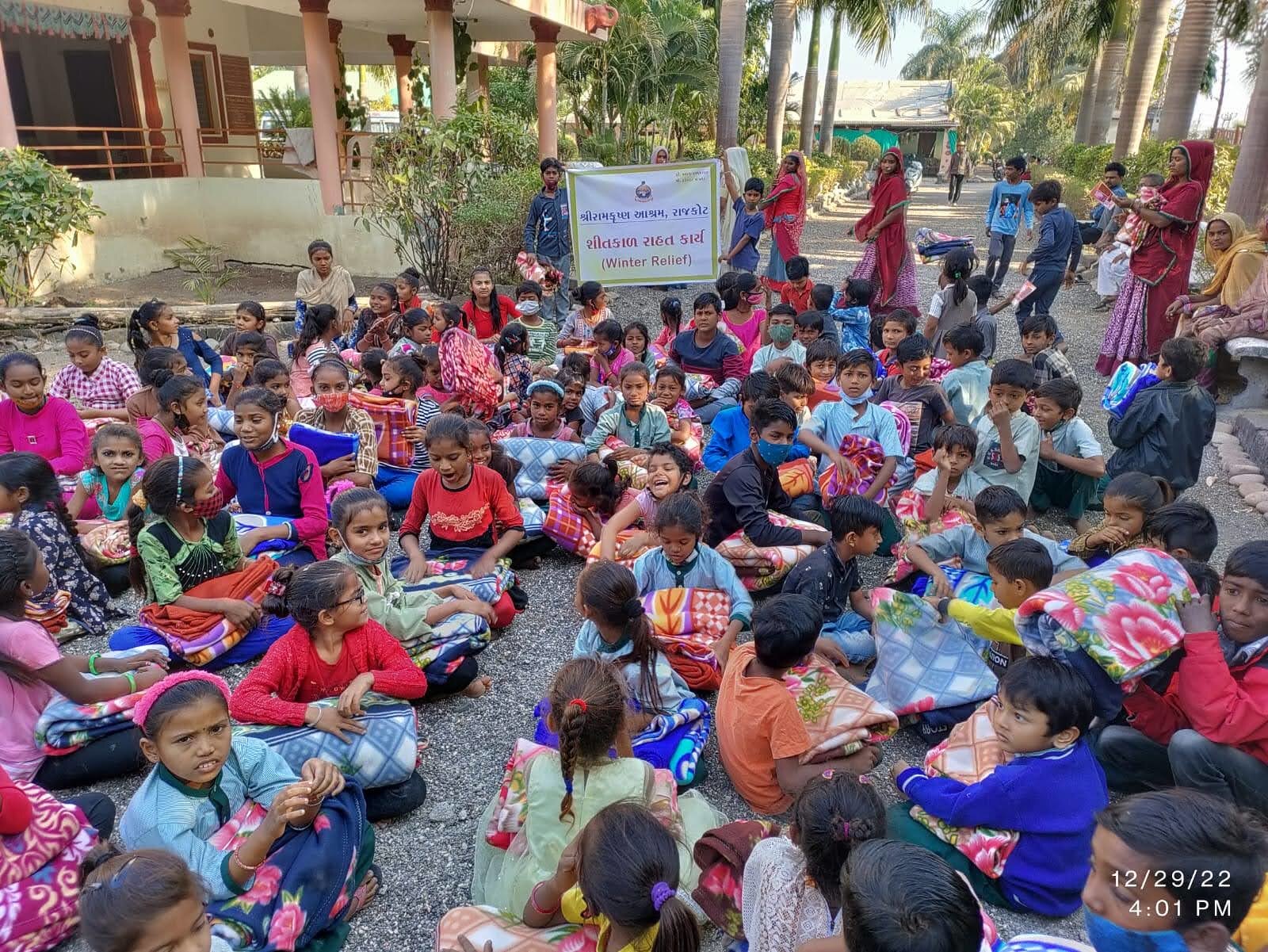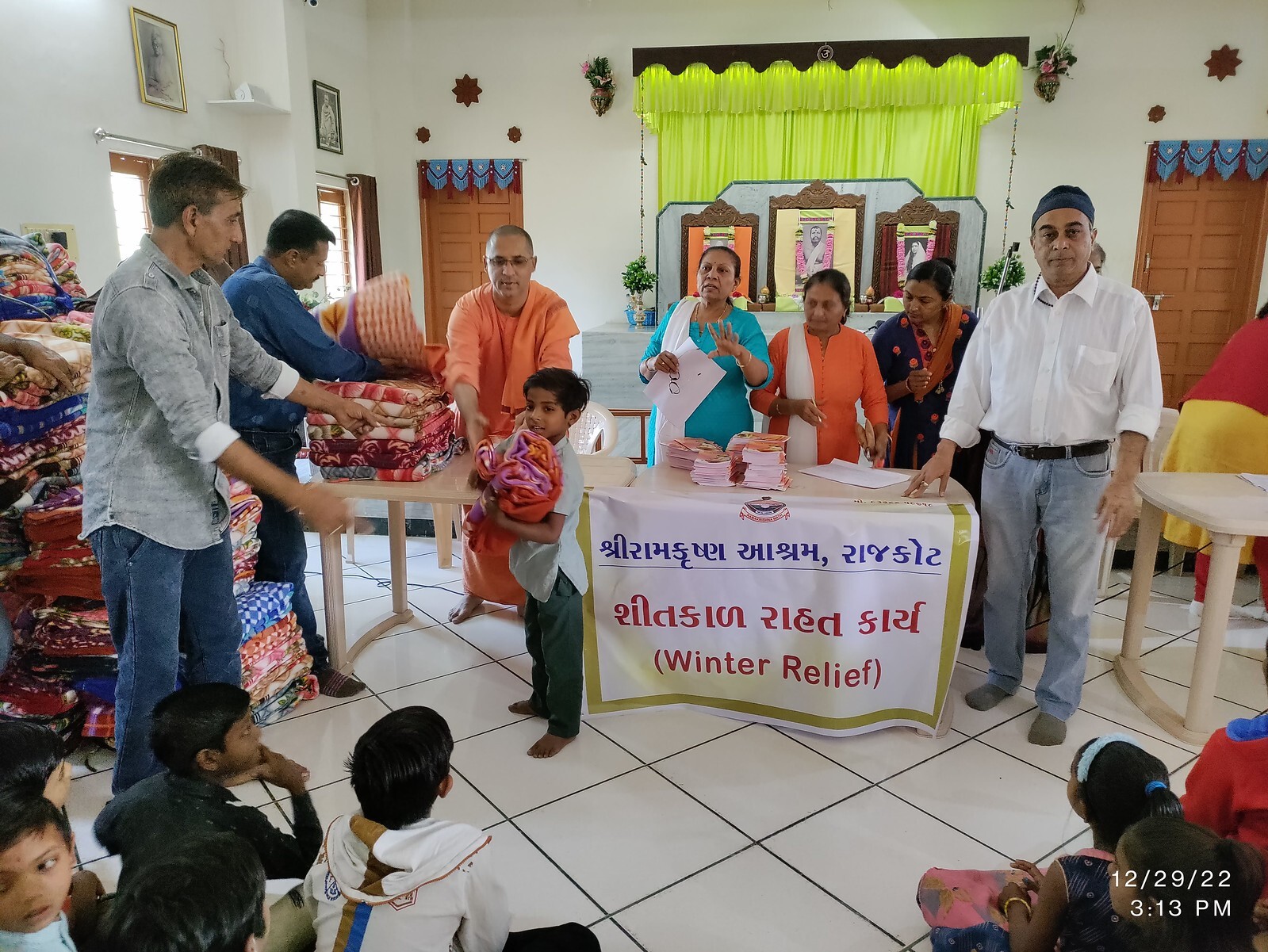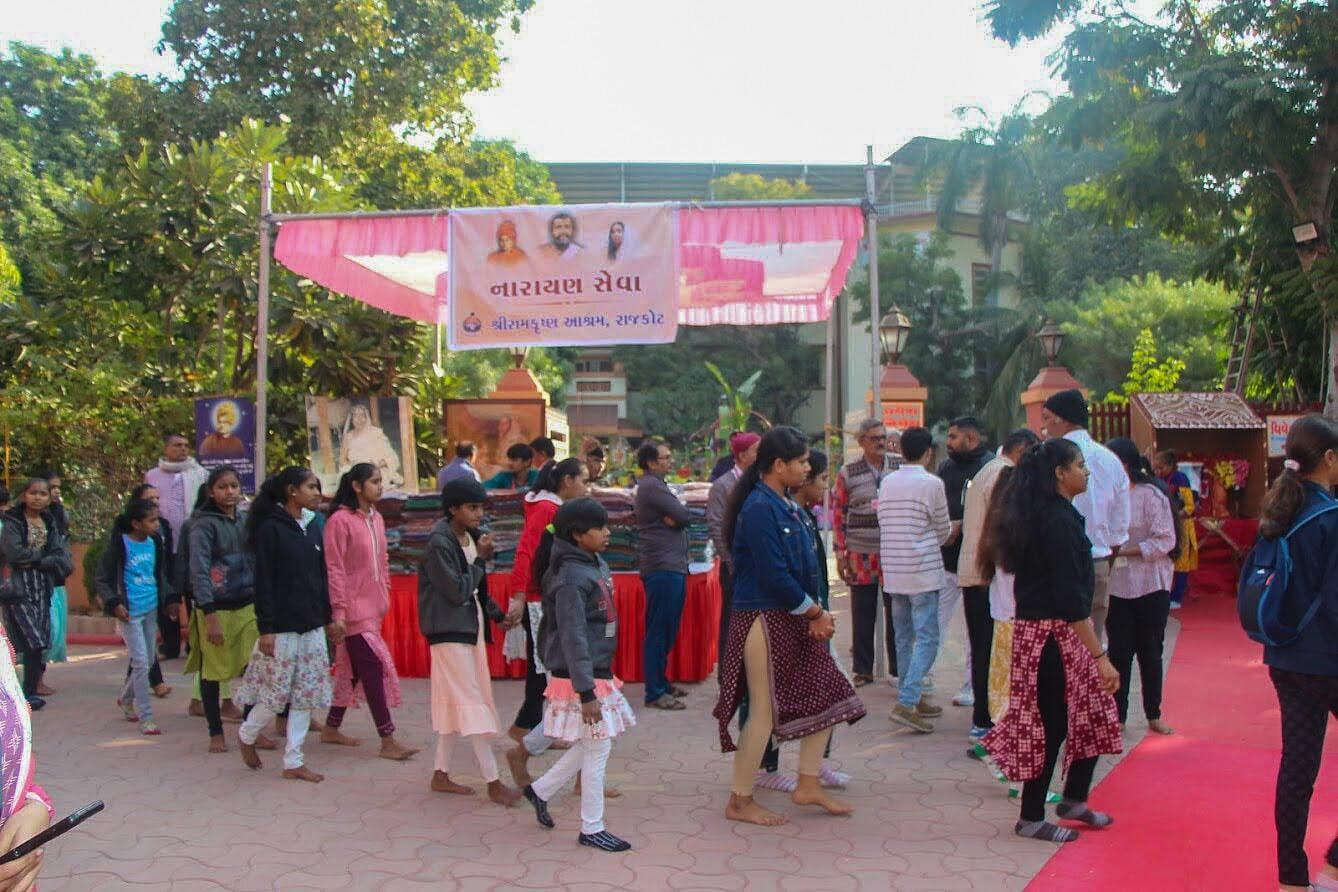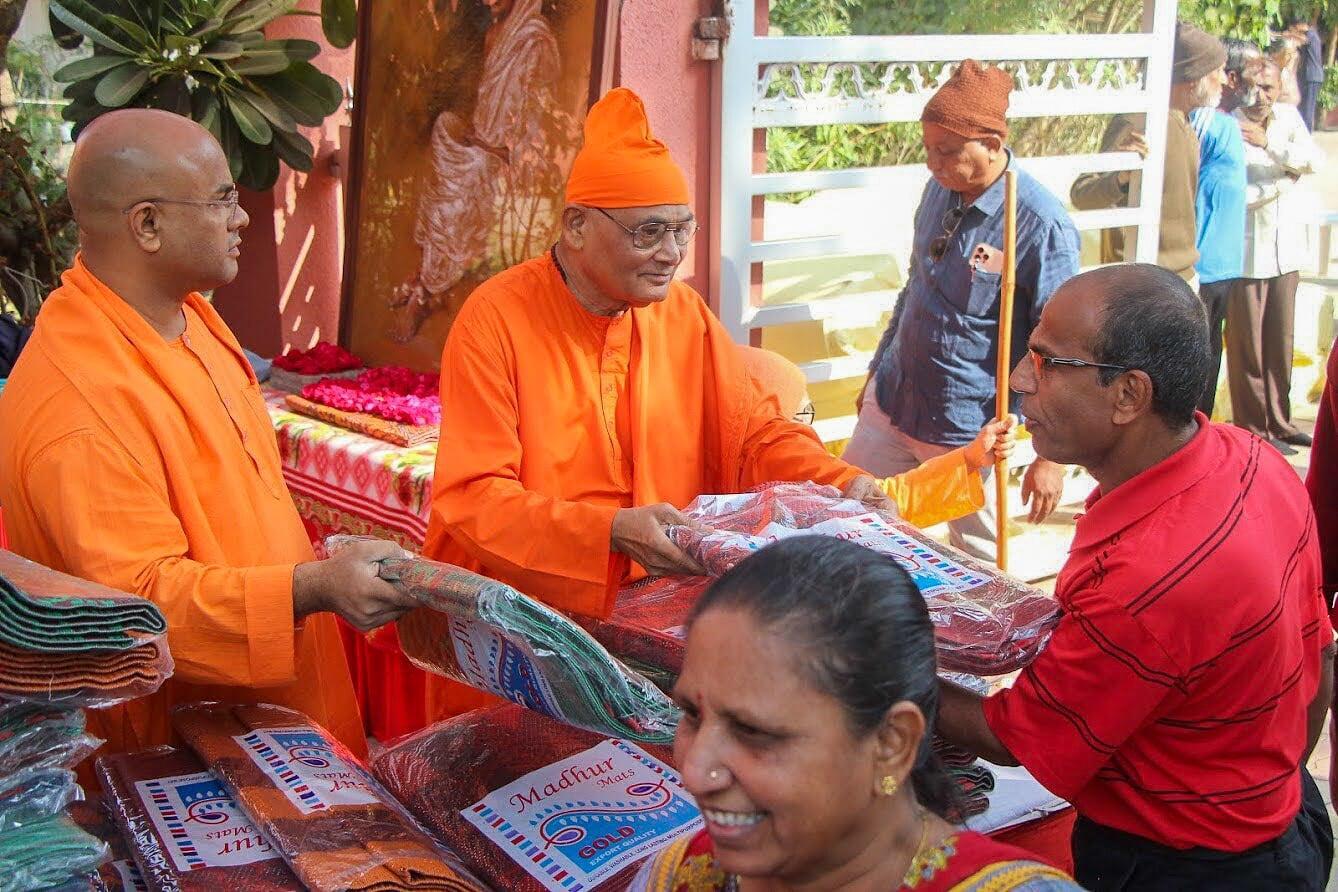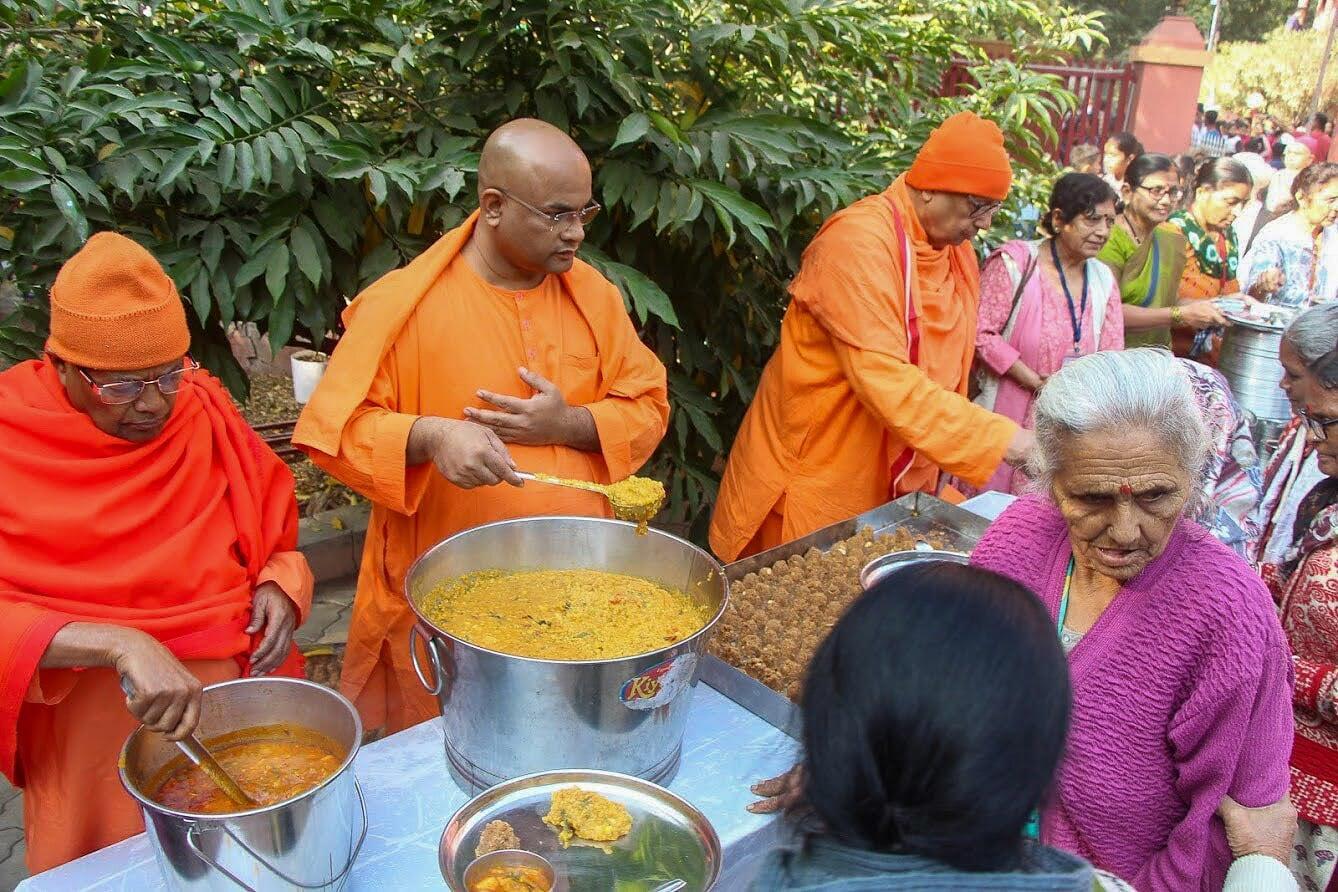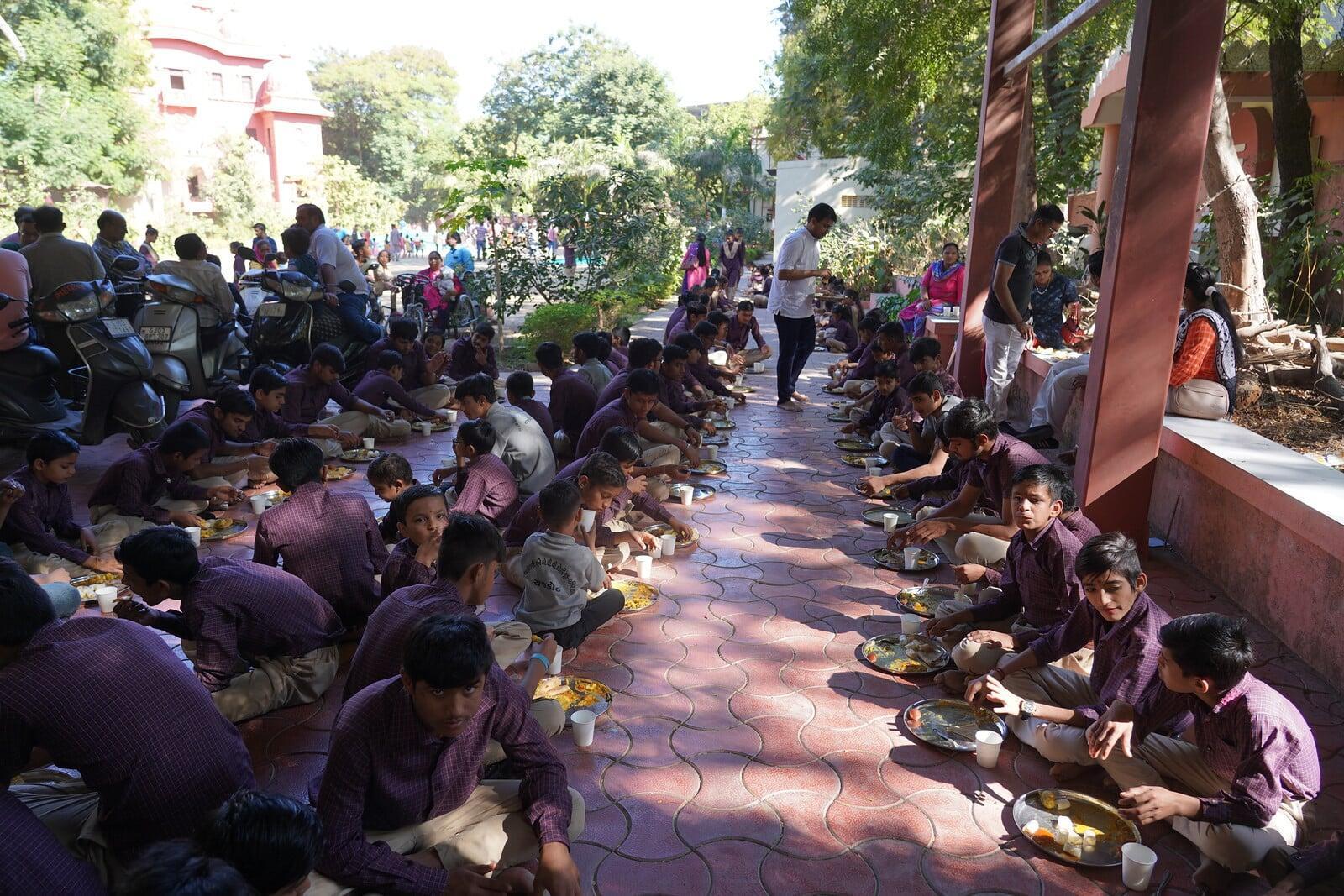Relief Activities
Relief and Rehabilitation Activities

Shri Ramakrishna once, raised a pertinent question: “If God can be worshiped through an image, why shouldn’t it be possible to worship him through a living person?” “Does Gad exits only when I think of him with my eyes closed? Doesn’t He exist when I look around with my eyes open?” Fortunately, later Shri Ramakrishna himself resolved the question by expounding his wonderful doctrine of “Service to man as worship to God.”
This is then the philosophy behind the various humanitarian services under taken by the Ramakrishna Mission. Inspired by this philosophy Shri Ramakrishna Ashrama, Rajkot has been conducting various service activities in its own humble way since its inception in 1927.
The Relief activities of Shri Ramakrishna Ashrama, Rajkot began as early as 1927. In co-operation with Ramakrishna Math, Khar, Bombay, the Ashrama conducted relief work from March 1927 to February 1928 in Cambay, Baroda and British territories affected by the disastrous flood of 1927. 4366 persons of 1953 families were helped with relief materials. 920 houses were constructed for the homeless.
Relief & Rehbilitation
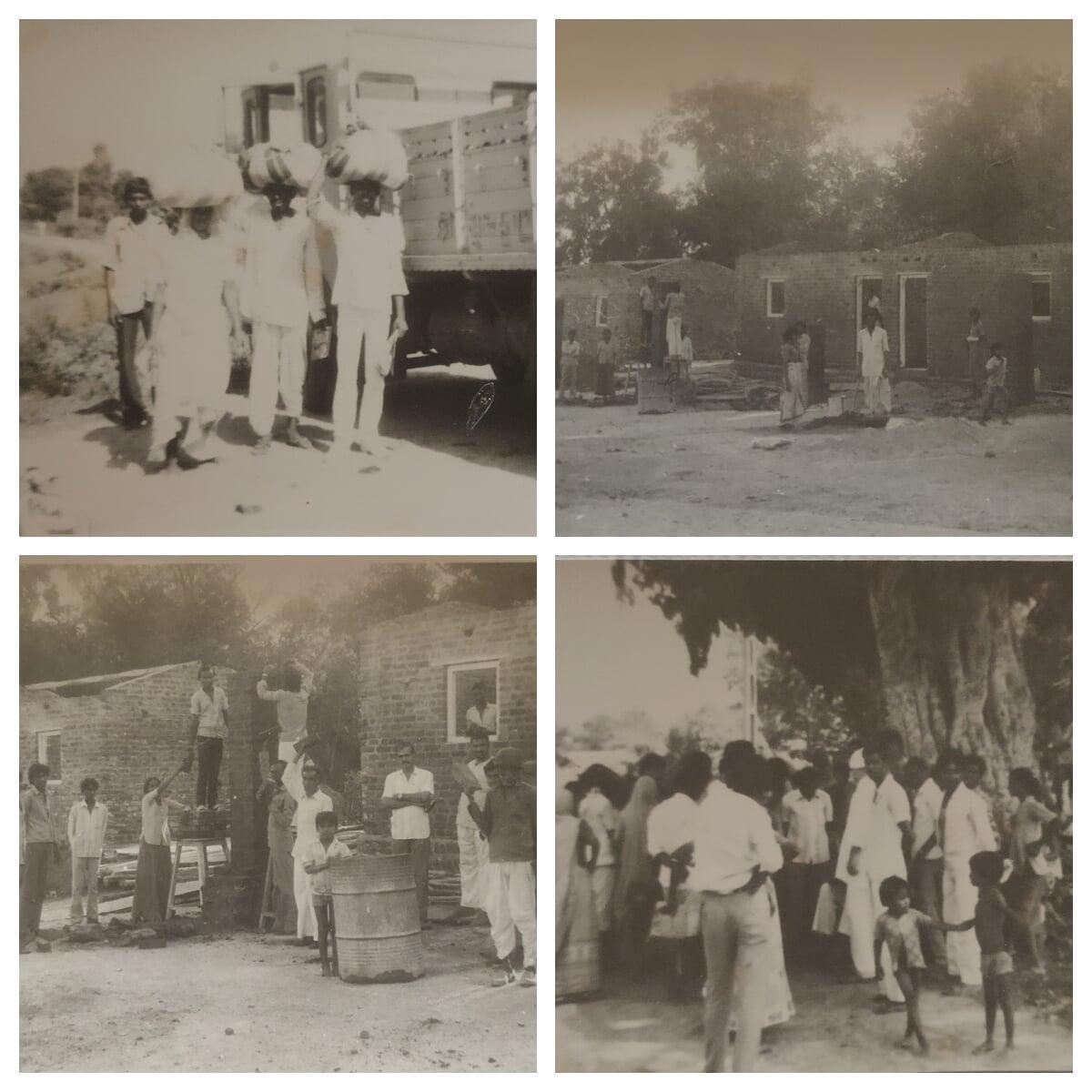
On 14 July 1959, heavy rains resulted in floods in Abdasa, Anjar, Bachau, Bhuj, Mandvi and Rapar Talukas of Kutch District. In collaboration with Ramakrishna Mission, Mumbai the Ashrama started extensive primary relief work. The Ashrama distributed food grains, cloth, blankets and other relief materials worth Rs. 3,32,625/- in the above talukas. Thus a total of 23795 people (5099 families) belonging to 265 villages were covered in this massive primary relief work. Then rehabilitation work was started and 70 houses and a prayer hall were constructed at a total cost of Rs. 1,90,000/- for the homeless families of Bhuj city at the outskirts of the city. The foundation stone of the colony was laid by Shri Morarji Desai, the Finance Minister of India, and the colony, as Sri Ramakrishna Dham, was inaugurated on 30 December 1960 by the Governor of Gujarat, Sri Nawab Mehandi Nawaj Jung Bahadur.
On 2 July 1960, heavy rains houses spontaneously resulted in flash floods in the districts of peaceful. Junagadh and Rajkot. Many houses were damaged or totally washed out. I he Ashrama provided help to several families to repair their houses. Later on, the Ashrama built 28 houses in Arabtimbdi and 13 houses in Bavapipalia Villages in Rajkot District. Similarly 48 houses In Majevadi and 10 houses in Vada Simbdi.
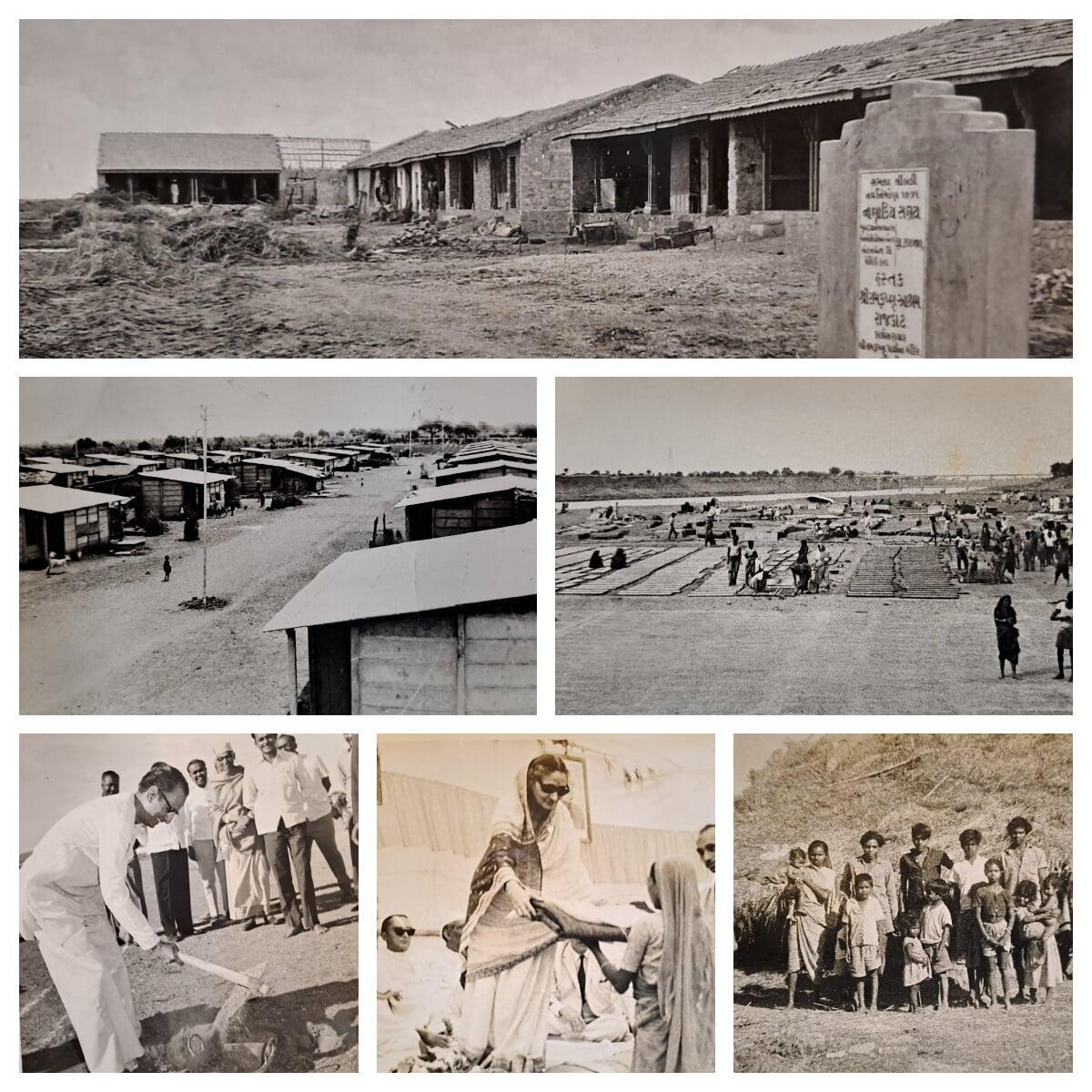
In 1968, Surat District was devastated by a massive flood. The Ashrama undertook rehabilitation work in 23 villages of Kamrej Taluka. A poor old lady Kankuben came forward to generously offer her own land for rehabilitation of the poor flood victims. 1400 pre-cast concrete houses were erected. In each village a Samaj Mandir was also constructed. Many houses were electrified. Complete water-supply arrangement with overhead tanks, water reservoirs fitted with electric pumps and pipelines were also provided for in each of the village with other necessary amenities. The total expenditure incurred was Rs. 20,00,000/-. Shri Hitendrabhai Desai, Chief Minister of Gujarat inaugurated the colony at Kamrej.
In the month of September 1973, there were unprecedented floods in Banaskantha and Panchamahal districts, The Ashrama rushed to those areas. Besides immediate relief, the Ashrama undertook the Rehabilitation work of a village named Bhoyan in Deesa Taluka of Banaskantha District. A model village was built in Bhoyan for 200 families with all necessary amenities. The Ashrama also distributed some quantity of Bajra among the poor and needy people. The Ashrama also distributed 600 woollen blankets and warm clothing amongst the affected people.
In 1977 unprecedented heavy rains flooded the low- lying areas of Baroda city. 4000 kg. Wheat, 400 pcs. Blankets, 385 sets of utensils were distributed among 586 families. 1440 notebooks were distributed to poor students.

On 11 August 1979, a devastating flood hit the town Morvi. Within two and half hours of the disaster monks and devotees of Ashrama rushed with primary relief materials to Morvi. On 13 August hundreds of persons were evacuated from the town by Ashrama volunteers in trucks and buses. Food packets, grain bags, and cloth bundles were supplied for air dropping by helicopters in unapproachable areas of Maliya Taluka. Ten Swamis and about 300 volunteers worked round the clock during the primary relief. A camp was established in Darbargadh at Morvi. Covering all the 38 affected villages and Morvi city; the Ashrama distributed materials worth more than Rs.15 lacs among more than 14,000 families. More than 143 tons of prepared food, food packets, about 243 tons of dry ration, l 6,000 pieces of utensils, about 60,000 pieces of clothing and bedding, along with large quantity of soaps, match boxes, candles and varieties of articles of daily necessities and medicines were distributed.

On 24 June 1983, the Ashrama rushed with primary relief materials to the flood-devastated areas of Junagadh district. Nearly 8298 families of 90 villages were supplied with food-stuff, clothes, utensils and other articles of daily use. The Ashrama also provided cows and camels to persons who had lost their animal during the flood. A total number of 838 cows, 27 camels and other domestic cattle were distributed free of cost as a part of economic rehabilitation. Skilled workers were provided with tools and equipment for carrying on their respective trades. Thus attempts were made to create job opportunities for the villagers in various ways so that they may start earning on their own. From April 1983 to March 1985, rehabilitation work was undertaken in Junagadh District. A colony with 84 houses, one primary school, one dispensary, and staff quarters, was constructed at Anandpur-Mevasa village. Another colony of 36 houses, one primary school along with staff quarters, was built in Itala-Patapur village. In Kerala village one primary school building with staff quarters was built. In all the above three colonies, three new wells were dug. A total of Rs.30,64,690/- was spent by the Ashrama for Relief and Rehabilitation activities during the period 1983-84.
In 1991, 28 houses in the lower area of Bhamaria village (Taluka: Gariadhar) of Bhavnagar District were virtually wasted out during the floods. The Ashrama took up the Rehabilitation work on 20 February, 1991. On 31 July 1991, the Chief Justice of Gujarat High Court inaugurated the small township ‘Ramakrishnanagar’ of 28 houses (Two rooms with verandah and R.C.C. roof) and a temple cum-community prayer hall called “Shri Sharada Devi Prarthan Mandir”. The entire project cost about Rs.6.5 lacs. On 13 December 1991, Shri Chhabildas Mehta, the Finance Minister of Gujarat inaugurated the newly constructed school ‘Vivekananda Vidyalaya’ with five rooms, verandah and a compound wall, The cost of the school building as about Rs. 4.5 lacs. Nearly seven hundred students were supplied with a set of school uniform each.
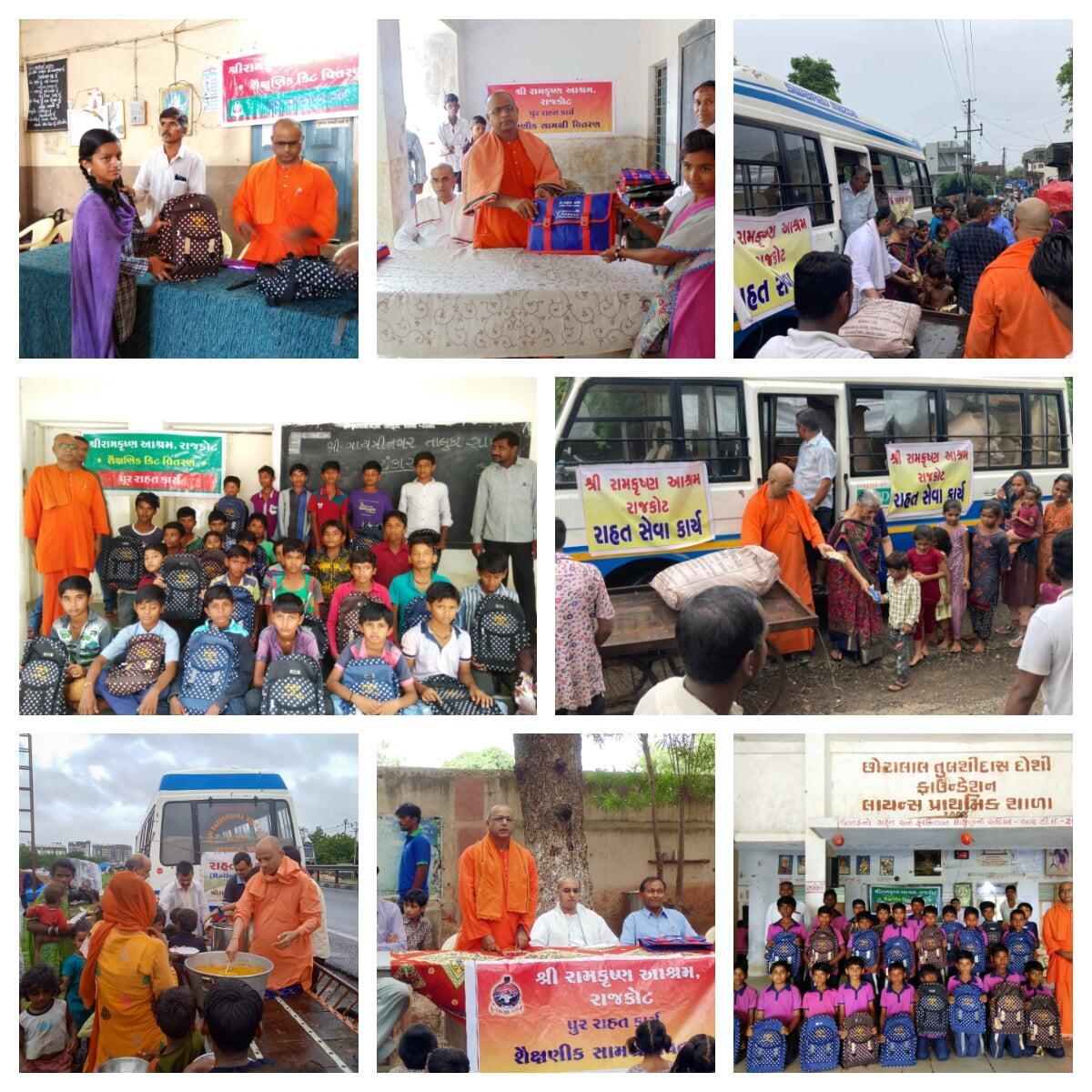
In 2017, Ashrama started relief work in the severely affected areas of Morbi District. Ashram served cooked food to around 17,600 flood affected people of ‘Maliya’ & ‘Mitana’ Villages of Morbi District. A temporary kitchen was started in a nearby School where the villagers were served with cooked food.
In the second phase, the Ashrama also distributed educational kits (consisting of school bag, compass box with writing materials (5 items), water bottle, three note books) among 336 students of 3 schools at ‘Maliya – Mitana’. The remaining 324 kits will be distributed on 22nd August 2017.
The Ashrama spent Rs. 1,97,442/- towards the above Relief Work Rs. 1,01,998/- & Rs. 95,444/- were spent towards Cooked Food distribution & Educational Kits Distribution respectively.
Some Districts of North Gujarat viz. ‘Sabarkantha’, ‘Banaskantha’ & ‘Patan’ were also affected by the floods due to heavy rains. A group of volunteers with one monastic member & vehicle joined the Relief Operations conducted by our Vadodara & Ahmedabad Centres from 29.07.2017 to 04.08.2017.

In 1970, the Ashrama conducted relief in drought-affected Kutch District. Cooked food was distributed amongst thousands of people belonging to 24 villages of Bhuj Taluka through its camp at village Dhaneti. New clothes were distributed; agricultural assistance by way of distributing bullocks, seeds and fertilizers was also provided.
In 1973, during the severe drought, the Ashrama opened a free kitchen in Bhadla under Jasdan Taluka and fed a thousand starving village people every day.
In 1975, a total quantity of 30,885 kg of wheat was distributed at a subsidized rate of Rs.1/- per kg among 2972 families in Rajkot city.
In 1986-88: – Gujarat experienced a severe drought lasting over three years from 1986 to 1988. The Ashrama started its Drought Relief activities in March 1986 for the distressed people and starving cattle by distributing food grains, drinking water, clothing etc. among the poor people, and cattle-feed and drinking water for their cattle. The district covered are: Rajkot, Surendranagar, Jamnagar, Junagadh, Kutch, Kheda, Panchmahal etc. The Ashrama distributed 6,72,616 kg of food-grains, 20,607 kg of dal, jaggery and milk powder, 1955 packets of biscuits, 26,962 meters of cloth, 2,05,02,000 liters of water, 5,250 pcsof tiles and tarpaulin sheets and other items like sewing machines, diesel engine pumps etc. The Ashrama also distributed 56,07,909 kg of green and dry fodder among the suffering cattle. The total beneficiaries were 91,800 people and about 55,000 cattle belonging to 1,201 villages in 26 talukas of the above 7 districts. The total expenditure incurred during the drought relief was Rs. 78,01,849/-.
In February 1994, fodder and medicines etc. were distributed to nearly 228 cattle of Katkola village of Bhanvad Taluka (Jamnagar District). In March 1994, 424 sets of clothes, 207 saris and 2512 kg of wheat was distributed among 299 drought affected families of Khatumbha and Goriyali villages of Dwaraka Taluka (Jamnagar District). In April 1994, 3000 kg bajra, 3900 kg cattle feed and two truck loads of fodder were distributed among 296 drought affected families of Barda Hills area of Bhanvad Taluka. In May 1994 as a part of drought relief work, 16,105 kg of fodder was distributed among 458 families in 4 villages of Dahod and Jhalod Taluka of Panchmahal.
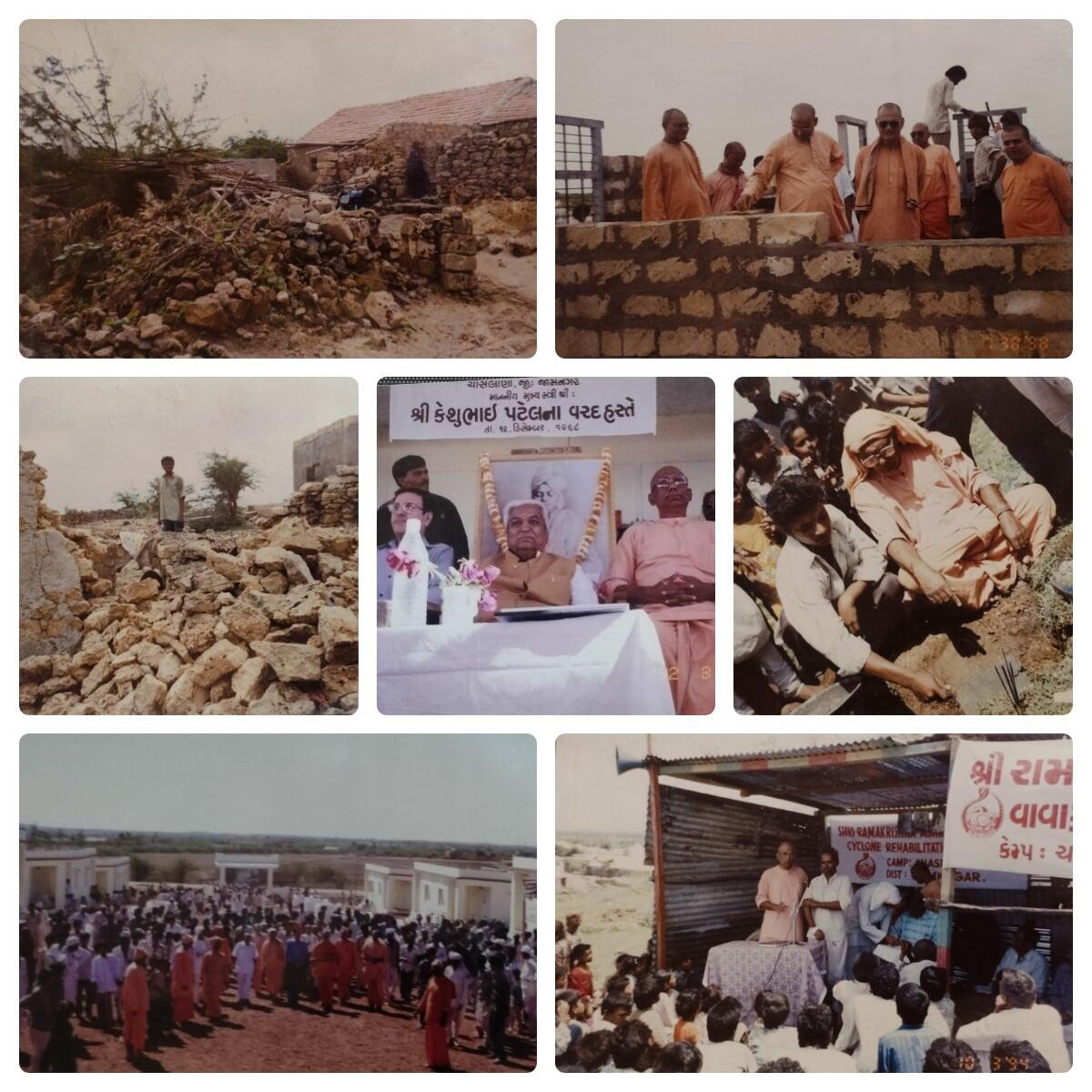
In 1975-76, a severe cyclone struck the coastal districts of Saurashtra in October 1975. Relief work was conducted from November 1975 to February 1976 in more than 100 villages of Jamkhambhaliya, Kalyanpur and Jodiya Talukas of Jamnagar District, Porbandar Taluka of Junagadh District, and Maliya Taluka of Rajkot District.A total number of 579 woollen blankets, 1000 cotton blankets, 178 dhotis and 2,270 meters of long cloth were distributed.
In November 1982, the three districts of Amreli, Bhavnagar and Junagadh were struck by a cyclone. Primary relief materials like woollen blankets, clothes, utensils and food stuff were distributed among 2546 families of 38 villages in 8 talukas of the above districts.
In 1996, 6,500kg bajra, 650 chadars were distributed among 650 families in 3 villages in Dahod and Jhalod Talukas of Panchmahal District. In May 1996, a community hall was constructed in Nimach village. 800 saris were also distributed in 4 villages of Dahod Taluka.600 cyclone affected people were served with cooked food in Nimach.
From 9 to 11 June 1998, a severe cyclone struck Porbandar, Jamnagar and Kutch Districts. The Ashrama started immediate primary relief and food packets were distributed among the cyclone hit people on 10 and 11 June. From 12 June, several truckloads of primary relief materials were sent for distribution in Adipur,Bhuj, Anjar, Kandla and Gandhidham towns. 16,500 kg food grains, tea, sugar etc, 460 kerosene stoves, 1,250 plastic buckets, 2,000 pcs kits (soap, candle, match boxes), 1,000 sets steel utensils, 8,000 pcs new clothes, 3,000 saris, 1,000 chaddars and 42,000 loaves of bread were distributed among 1,655 families in 20 different areas of the cities and adjoining villages of Kutch Distict. The Ashrama also conducted primary relief in the districts of Jamnagar and Porbandar. 11,200 kg food grains, 800 sets steel utensils, 1,600 kits (soap, candle, match boxes), 400 plastic buckets, 55 stoves, 200 chadars, 2,400 saris and 4,800 new clothes were distributed among 800 families of 12 different areas of the towns and surrounding villages of Jam Khambaliya and Jam Kalyatpur (Jamnagar District). 450 kits (each kit consisting of food grains, vegetables, clothes, steel utensils, chadars, saris, kerosene stove etc) and 1255 polythene sheets were distributed among 575 most affected and needy families of Porbandar District. After the primary relief work massive rehabilitation work was undertaken. At Chaslana village (Jamnagar District) 30 pucca houses, one samaj mandir, a children’s’ park, and a temple were constructed. The colony was inaugurated by the Chief Minister of Gujarat, Shri Keshubhai Patel on the 12 December 1998.
The India Meteorological Department (IMD) on 12th June, 2019 announced that the Cyclone Vayu has intensified into a severe cyclonic storm and is likely to hit the Gujarat coast on 13th June, 2019 morning. Around three lakh persons were shifted to safer places as a precautionary measure in Kutch, Morbi, Jamnagar, Junagadh, Devbhoomi-Dwarka, Porbandar, Rajkot, Amreli, Bhavnagar and Gir-Somnath districts, which were expected to bear the brunt of the cyclone. Fortunately, the cyclone changed its direction and a great catastrophe was avoided. Shri Ramakrishna Ashrama, Rajkot prepared 5300 food packets and distributed among the displaced, poor and needy people of 24 areas of Rajkot, Morbi and Gir- Somnath districts. Each food packet contained 100 gm Gathiya, 100 gm Bundi and 50 gm Sev mamara. Total expense was Rs. 1,26,158/-
In 1994 after the rains there was a plague epidemic in Surat. The monks of the Ashrama, with several volunteers, rushed to the city of Surat risking their own lives and conducted primary relief by distributing 12,080 kg wheat among 1,208 families in two worst affected areas of the city.


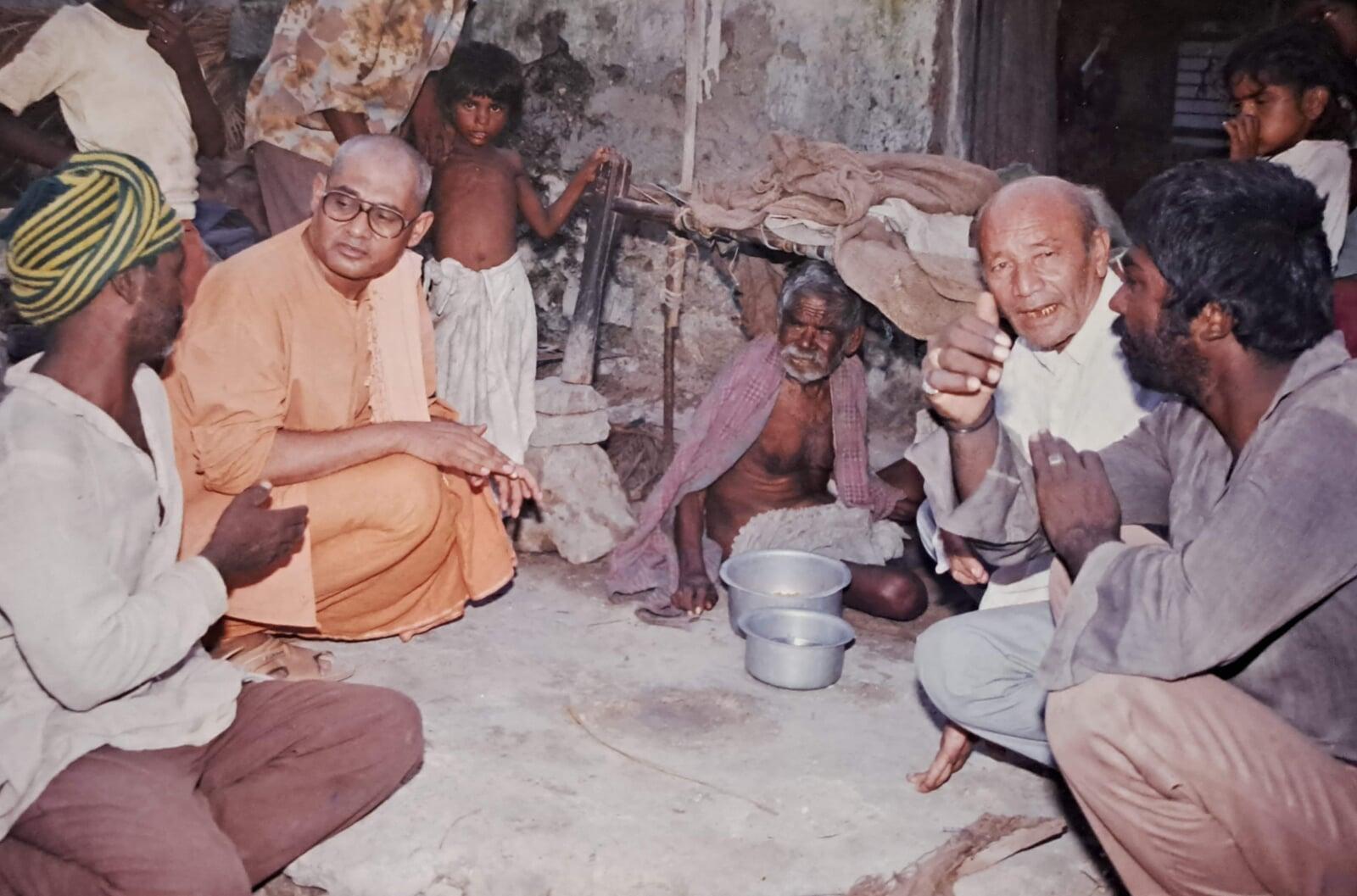
Shri Ramakrishna Ashrama, Rajkot distributed essential clothing items such as shirts, trousers, and children's garments to hundreds of families who struggle to afford basic necessities as a part of distress Relief work. The beneficiaries included economically disadvantaged individuals, daily wage workers, and people from marginalized communities.



As a part of ongoing relief work in connection with the global outbreak of Corona-Virus, Shri Ramakrishna Ashrama, Rajkot distributed 4052 kg rice, 785 kg wheat, 2737 kg flour, 1136 kg dal, 936 litres edible oil, 1762 kg potatoes, 908 kg onions, 736 kg sugar, 352 kg assorted spices, 152.75 kg tea leaves, 611kg salt, 579 packets of biscuit, 979 bars of soap among 936 families in Rajkot & Kutch district from 30th March to 7th April, 2020.
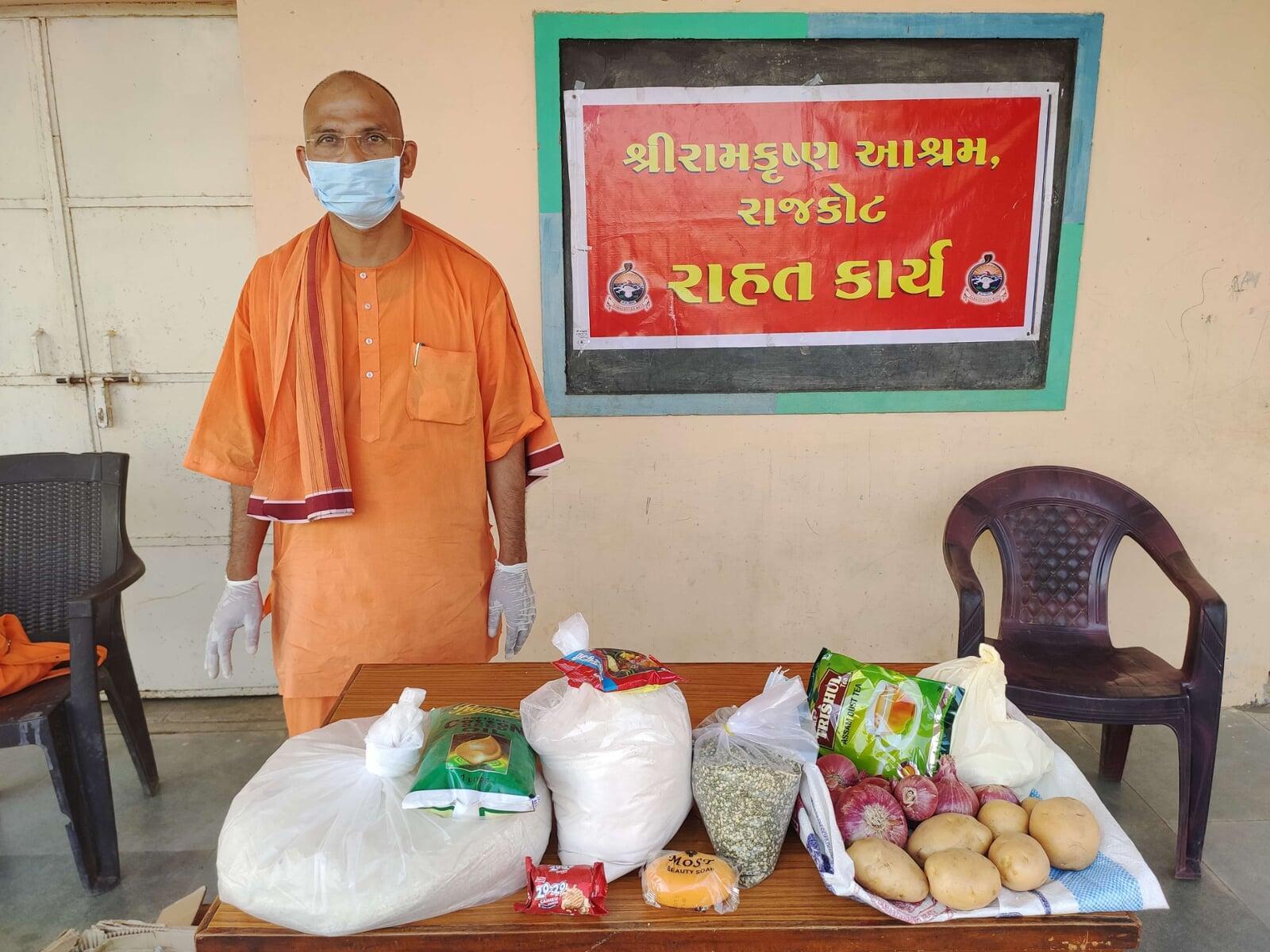

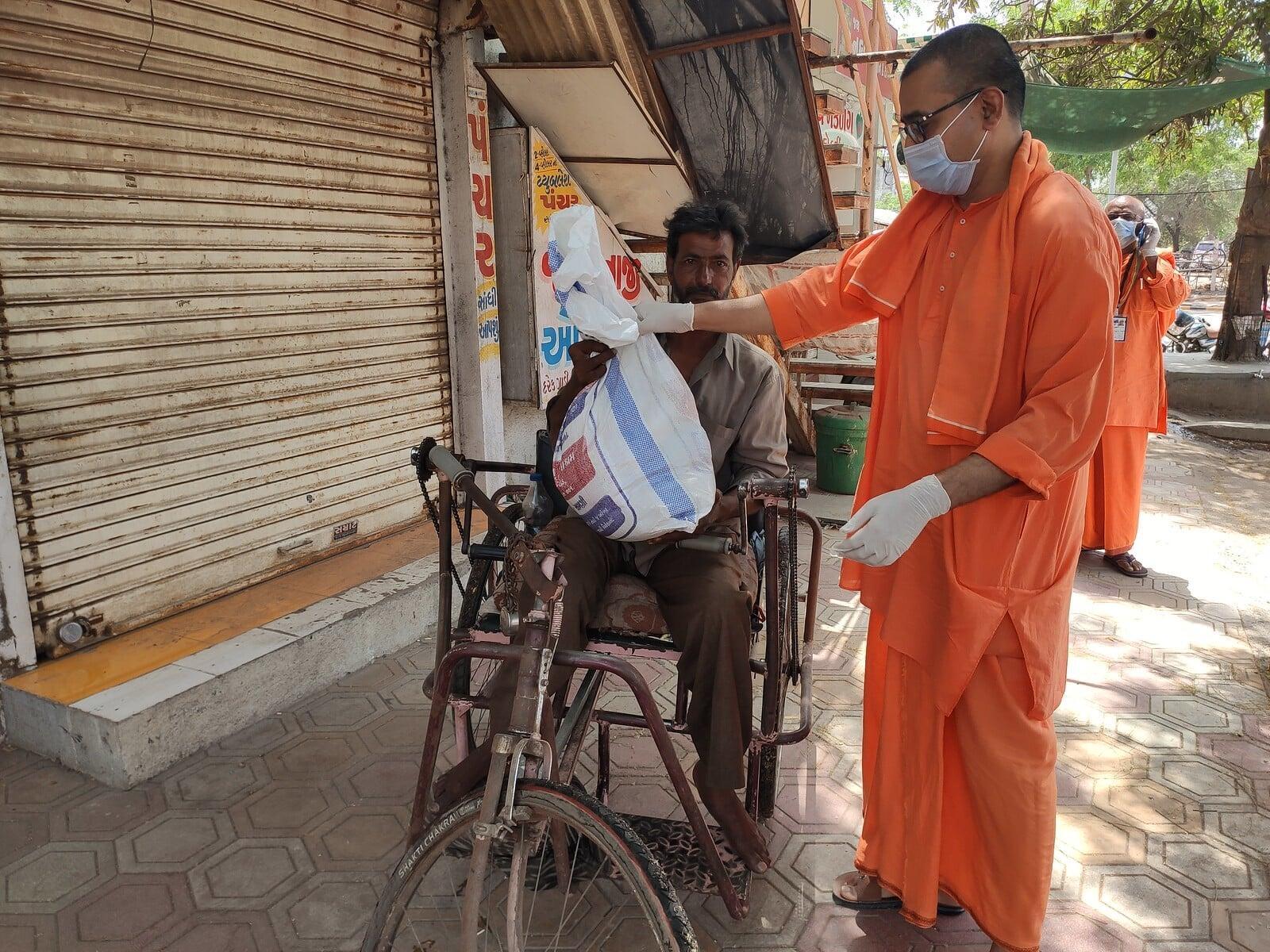
Ramakrishna Ashrama, Rajkot distributed 2097 blankets to the students of Mongiba Girls High School, Gondal city, Rajkot District (415 blankets) and the students and residents of Upleta city of Rajkot District (411 blankets), in December 2022-23.
